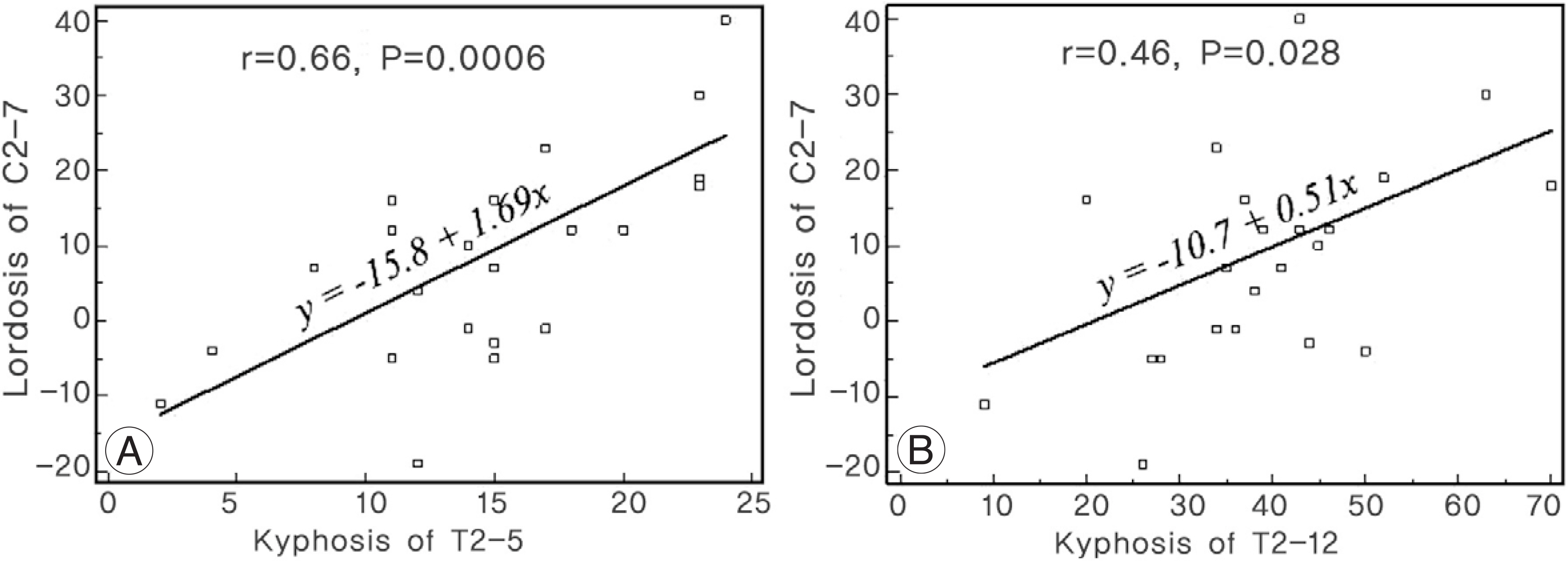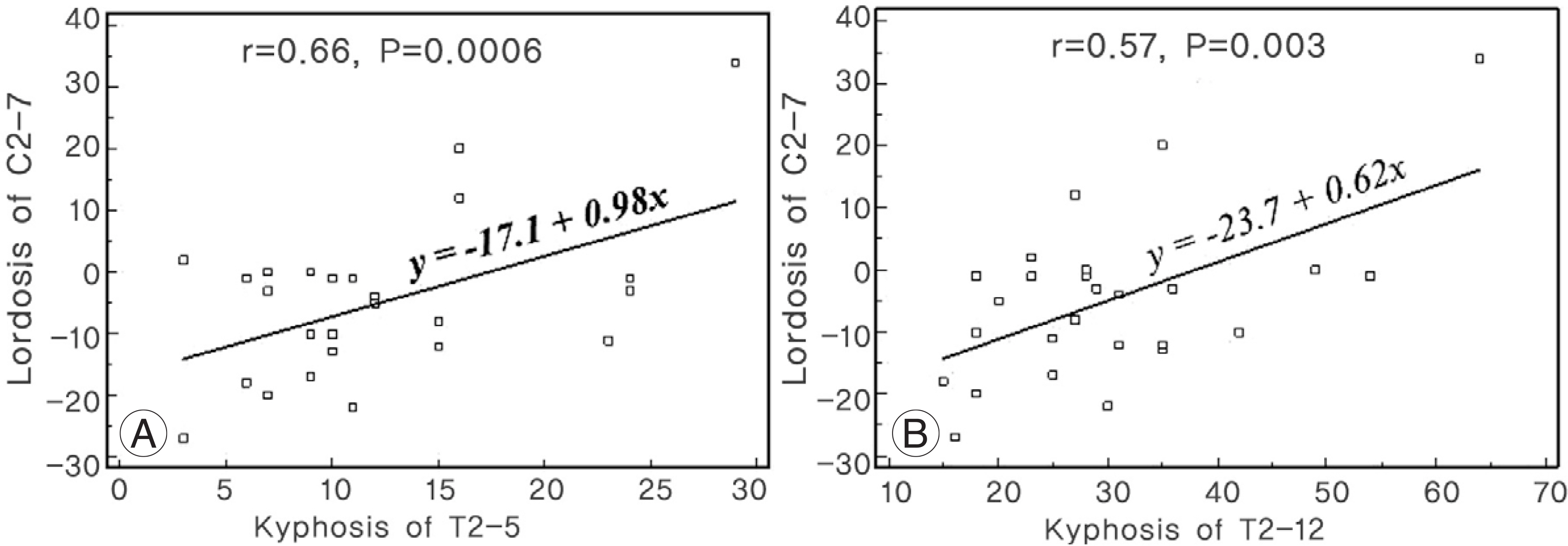J Korean Soc Spine Surg.
2009 Sep;16(3):167-172. 10.4184/jkss.2009.16.3.167.
Cervical and Thoracic Sagittal Curves in Thoracic Adolescent Idiopathic Scoliosis
- Affiliations
-
- 1Seoul Spine Institute, Inje University Sanggye Paik Hospital, Seoul, Korea. sskim@paik.ac.kr
- KMID: 2003110
- DOI: http://doi.org/10.4184/jkss.2009.16.3.167
Abstract
- STUDY DESIGN: Prospective study
OBJECTIVES
To analyze and compare the cervical and thoracic sagittal curves between normal adolescents and patients with thoracic adolescent idiopathic scoliosis (AIS). SUMMARY OF THE LITERATURE REVIEW: There are no reports on cervical sagittal curves and its correlation with thoracic sagittal curves in AIS.
MATERIALS AND METHODS
The sagittal curves were analyzed in normal adolescents (N-adol group, n=23) and patients with thoracic AIS (AIS group, n=26) who had thoracic curves > or = 45degrees. Lateral standing radiographs of the cervical spine with a elbow straight and the whole spine with the hands on the clavicles were taken. The sagittal curves and balance were measured in the following segments; C2-C7, T2-T5, T5-12, T2-12, T12-S1. Cervical lordosis (C2-C7) was measured in both cervical spine radiographs and whole spine radiographs.
RESULTS
In the N-adol group, the cervical lordosis was 9.2+/-14.6degrees in the cervical spine radiographs and -0.6+/-12.9degrees ('-' means kyphosis) in whole spine radiographs. In the AIS group, cervical lordosis was -5.0+/-12.9degrees in the cervical radiographs and -8.1+/-12.7degrees in the whole radiographs. The AIS group had significantly less cervical lordosis than the N-adol group. Thoracic kyphosis of T5-12 and T2-12 was 24.1+/-10.6degrees and 38.9+/-13.1degrees in the N-adol group, respectively, and 17.8+/-9.4degrees and 30.1+/-11.8degrees in the AIS group, respectively. There was a significant difference between the two groups (Ps<0.05). There was no significant difference in thoracic kyphosis of T2-T5, lumbar lordosis and sagittal balance between the two groups (Ps>0.05). In the AIS group, the cervical lordosis measured in the cervical spine radiograph showed a positive correlation with thoracic kyphosis of T2-5 (r=0.50, P=0.009) and T2-12 (r=0.57, P=0.003).
CONCLUSIONS
AIS patients had significantly less cervical lordosis and thoracic kyphosis than normal adolescents. Decreased cervical lordosis in AIS had a significant correlation with their relative thoracic hypokyphosis.
MeSH Terms
Figure
Reference
-
1). Suk SS, Lee SM, Chung ER, Kim JH, Kim SS. Selective thoracic fusion with segmental pedicle screw fixation in the treatment of thoracic idiopathic scoliosis. Spine. 2005; 30:1602–1609.
Article2). Horton WC, Brown CW, Bridwell KH, Glassman SD, Suk SI, Cha CW. Is there an optimal patient stance for abtaining a lateral 36” radiograph? A critical comparison of three techniques. Spine. 2005; 30:427–433.3). O'Brien MF, Kuklo TR, Blanke KM, et al. .:. Radiographic Measurement Manual. Spinal Deformity Study Group (SDSG). Medtronic Sofamor Danek;2004.4). Ohara A, Miyamot K, Naganawa T, Matsumoto K, Shimizu K. Reliabilities of and correlations among five standard methods of assessing the sagittal alignment of the cervical spine. Spine. 2006; 31:2585–2591.
Article5). Berthonnaud E, Dimnet J, Roussouly P, Labelle H. Analysis of the sagittal balance of the spine and pelvis using shape and orientation parameters. J Spinal Disord Tech. 2005; 18:40–47.
Article6). Park HJ, Jeon JS, Lee PE. Range of motion of cervical spine in normal Korean people. J of Kor Spine Surg. 2004; 11:83–89.
Article
- Full Text Links
- Actions
-
Cited
- CITED
-
- Close
- Share
- Similar articles
-
- Clinical Results of Selective Thoracic Fusion by Segmental Pedicle Screws in King type II Adolescent Idiopathic Scoliosis ( AIS )
- Specific Sagittal Curve Patterns of Cervical Spine in Adolescent Idiopathic Scoliosis (AIS)
- Indications of Proximal Thoracic Curve Fusion in Thoracic Adolescent Idiopathic Scoliosis(AIS): Recognition and Treatment of Double Thoracic Curve Pattern in Adolescent Idiopathic Scoliosis Treated with Segmental Instrumentation
- The clinical Study of Scoliosis
- A Clinical Observation on Idiopathic Scoliosis



